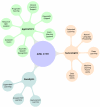Machine Learning and Artificial Intelligence in Intensive Care Medicine: Critical Recalibrations from Rule-Based Systems to Frontier Models
- PMID: 40565770
- PMCID: PMC12194786
- DOI: 10.3390/jcm14124026
Machine Learning and Artificial Intelligence in Intensive Care Medicine: Critical Recalibrations from Rule-Based Systems to Frontier Models
Abstract
Artificial intelligence (AI) and machine learning (ML) are rapidly transforming clinical decision support systems (CDSSs) in intensive care units (ICUs), where vast amounts of real-time data present both an opportunity and a challenge for timely clinical decision-making. Here, we trace the evolution of machine intelligence in critical care. This technology has been applied across key ICU domains such as early warning systems, sepsis management, mechanical ventilation, and diagnostic support. We highlight a transition from rule-based systems to more sophisticated machine learning approaches, including emerging frontier models. While these tools demonstrate strong potential to improve predictive performance and workflow efficiency, their implementation remains constrained by concerns around transparency, workflow integration, bias, and regulatory challenges. Ensuring the safe, effective, and ethical use of AI in intensive care will depend on validated, human-centered systems supported by transdisciplinary collaboration, technological literacy, prospective evaluation, and continuous monitoring.
Keywords: artificial intelligence; clinical decision support systems; critical care; deep learning; intensive care medicine; large language models; machine learning; natural language processing; predictive analytics; privacy; safety; sepsis.
Conflict of interest statement
The authors declare no conflicts of interest.
Figures


Similar articles
-
Artificial intelligence in critical care nursing: A scoping review.Aust Crit Care. 2025 Jul;38(4):101225. doi: 10.1016/j.aucc.2025.101225. Epub 2025 Apr 4. Aust Crit Care. 2025. PMID: 40187125
-
Signs and symptoms to determine if a patient presenting in primary care or hospital outpatient settings has COVID-19.Cochrane Database Syst Rev. 2022 May 20;5(5):CD013665. doi: 10.1002/14651858.CD013665.pub3. Cochrane Database Syst Rev. 2022. PMID: 35593186 Free PMC article.
-
Leadership in radiology in the era of technological advancements and artificial intelligence.Eur Radiol. 2025 Jun 27. doi: 10.1007/s00330-025-11745-4. Online ahead of print. Eur Radiol. 2025. PMID: 40579558
-
Machine Learning-Augmented Triage for Sepsis: Real-Time ICU Mortality Prediction Using SHAP-Explained Meta-Ensemble Models.Biomedicines. 2025 Jun 12;13(6):1449. doi: 10.3390/biomedicines13061449. Biomedicines. 2025. PMID: 40564166 Free PMC article.
-
Factors that impact on the use of mechanical ventilation weaning protocols in critically ill adults and children: a qualitative evidence-synthesis.Cochrane Database Syst Rev. 2016 Oct 4;10(10):CD011812. doi: 10.1002/14651858.CD011812.pub2. Cochrane Database Syst Rev. 2016. PMID: 27699783 Free PMC article.
References
Publication types
LinkOut - more resources
Full Text Sources

